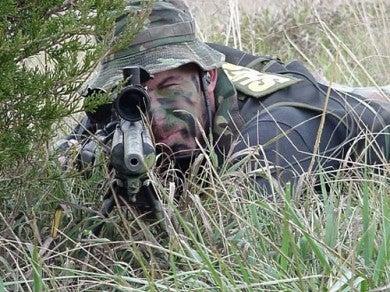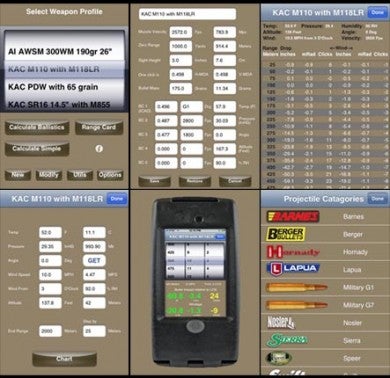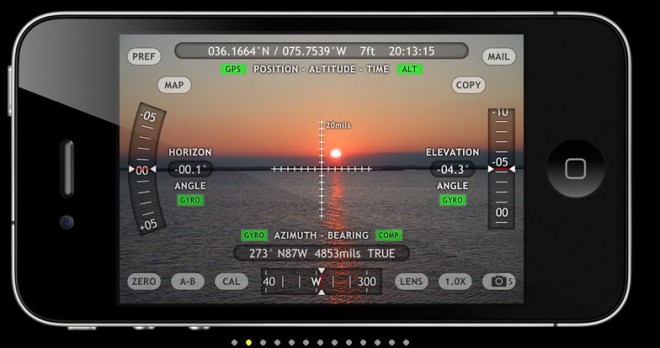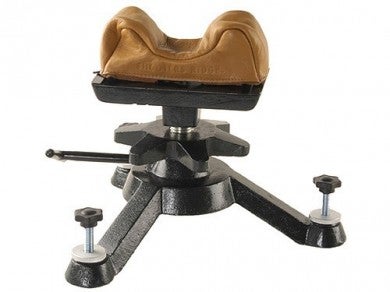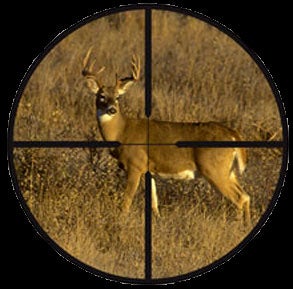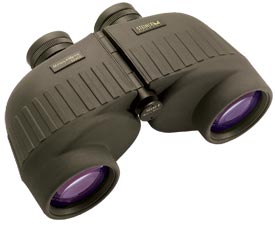Distance Shooting Like a Sniper
Major Pandemic 06.22.16
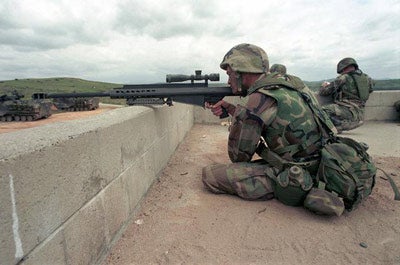
We all have a mental image of the quintessential sniper; a man who only needs his rifle and some camouflage to make the impossible billion-yard shot. The reality is that, whether you are sniper or Joe distance shooter, the fundamentals of shooting apply, and that does not mean going to the 500 yard range and blasting 1000 rounds downrange like a madman. In fact our range does not allow it for obvious safety reasons, because you have no idea where each of those bullets are going when doing something like that.
A military sniper once told me that I would be stunned how few rounds were fired on an average day at sniper training. He indicated it was more like hunting in that there is a lot of waiting and maneuvering and calculating, with a heck of a lot of analytical classroom work.
At heart, sniper training puts emphasis more on prepping for the shot, making the shot, and then a whole bunch of analysis about where it went and why.
Since most modern cartridges shoot flat enough for hunting out to 100-150 yards, most of us never really have to think about any significant holdovers. When is the last time you thought about barometric pressure, ambient temperature, ranging, scope adjustment, wind estimation, spin drift, and flight time before you took a shot at a deer?
Also, most target benchrest distance shooters are used to shooting nice and comfy on a level stable bench and picking “nice days for shooting” that are less temperate and less windy, ensuring fewer things to affect bullet flight. Snipers don’t have that advantage.
Any shooter that tries and has the right rifle and ammo can shoot sub-MOA (Minute of Angle) groups at 100 yards — but try that while it’s raining at dusk, shooting under a log while lying sideways in a muddy ditch with 30 MPH cross winds at a 400-yard target that is trying to kill you and your buddies.
iPhone Apps
The first step to shooting accurately at long distances is to figure out where the bullet will go. There are a couple iPhone apps I really like. One is military’s now-standard Knight’s Armament Corporation KAC BulletFlight series of apps in three versions from basic $3.99 to Military $39.99. If you want a comprehensive feature-rich app that gives you cutting-edge ballistics calculation including really complex spin drift calculations with most commercial and military caliber data loaded on board, this is the app to download.
The other iPhone ballistics bullet drop calculation app I like (and probably use more often) is iStrelok, a free or inexpensive app (depending on which version) that provides a complete range of ballistics calculation, but lacks the extra data inputs and sophistication of Bulletflight. But hey it’s cheap and has worked great for me breaking clay targets out to 400 yards.
This is more of a fast calculation app designed around Kentucky windage holdovers, but it does calculate scope clicks and the newer version can even do truing. The app shows you where to aim on various reticle designs (Mil Dot, NP-R2 & R1 Nightforce, TMR Leupold, Ballistic Mildot & XTR Ballistic Mildot, BR, SPR, and more). Set up your rifle and cartridge data and enter conditional information (distance, wind, temp, slope), and it shows you where to aim when you look through the scope.
Seems to work very well on 22 LR, 357, 9mm, and 308s that I have tried with it.
Another useful app is a distance estimation app for use with Mildot reticle equipped scopes is Snipers Mildot, which allows you to set the size of the target with a slider and use the other slider to match the height of the target as seen through your Mildot scope.
Most deer chests are 18″ tall so you can make pretty accurate yardage calculations with this, though not as accurate as a laser range finder. This app requires a Mildot scope on the noted calibrated power setting. It took me a little bit to figure out, but in the end it’s a handy tool for long range shooting.
Theodolite is another great iPhone app tool for shooting, surveying, outdoor enthusiast, and handyman use, which allows for precise angle calculation, distance and height calculations, GPS, Azimuth bearing, altitude, time, precision compass, and a host of other information critical for positioning and measurement. This is just a stunning display of what the embedded iPhone sensors can do and handy when shooting.
If you want to add some stress to your training, I recommend a Shot Timer, I have several including IA-Innovative Applications Shot Timer and Surefire’s Shot Timer, both free. These provide the beep and shoot with recording of total times, first shot, split time, and shot counts. I use these with a handgun and they can provide some stress during long range shooting as well. Adding a little urgency and stress to your long range shooting can really change your accuracy–and not for the better.
Dry Firing
I cannot possibly convey how much I have learned from dry firing. If you want to tighten your groups with rifle and pistol: dry fire, dry fire, and dry fire some more. This will improve your grip, will make you painfully aware of flinching, thumb squeezing, trigger yanks, and other issues that make you miss the target.
As a test the next time you are watching television, ensure your gun is completely unloaded, point it at the TV, and pull the trigger. Did your sight picture move when you pulled the trigger? Did you flinch like a newbie? Was there any movement? By dry firing the hell out of my pistols, I have significantly tightened my groups and now I am working through the same drills with my rifles.
A Good Rest
A great portable rest is your backpack, a Harris bipod, or even bean or rice bags that are really light and still provide the same utility as the lead bags (plus you can eat them if you have to go all nature-boy-survival). I also encourage practicing both standard and uncomfortable shooting positions while you are at the range. The reality is you can practice all you want in a bench, but when you start crouching or lying down, things change.
Ethical Questions
We all know the guy who considers hunting, buys a new 300 Magnum, puts three rounds through it, and heads to a guided hunt where he attempts 300-400-yard shots. He then brags that it took two shots, but he brought the beast down at 400 yards. This is totally irresponsible and inhumane.
We have a responsibility to make a clean kill. I pulled off a 150-yard squirrel shot one year, only to find that I shot its leg off and had to dispatch it upon retrieval. That haunts me to this day and if it would have been a deer I probably would have never hunted again, but it did teach me to to only take humane shots inside my field shooting capabilities. If you can’t cleanly take the game, don’t take the shot.
Also, you need to ask yourself “Can I safely make the shot from here? Am I shooting into a good backstop?” You need to answer these–correctly–before setting up to take the shot.
Observation
Sniping and hunting have a lot of similarities, starting with the hunt, which means a lot of glassing and looking with binoculars and not much shooting. You may have spent a pile of money for a rifle and scope, but the most critical hunting gear is an excellent set of binoculars in 8x or 10x magnification. I can guarantee you will find more game.
The other vital piece of equipment that is getting cheap is a rangefinder. My Nikon Riflehunter is awesome and will provide not only distance, but shot angle and/or adjusted shot distances affected by the angle to the target. Without good range estimation, that $2000 trip and hunt may leave you empty-handed from an incorrect holdover.
The Obvious Questions
Have you sighted in and do you know what the rifle will do at the 10, 25, 50, 74, 100, 150, and 200+ yards ranges with the ammo you are hunting and shooting with? Do you have that data printed out on a little waterproof card? A lot of guys figure that if they are good on the 100 yard range, that they are good at longer ranges, but that is not the case and experience validating ballistic calculator data is critical. Have you shot off the bench, prone, kneeling, and from seated in odd, uncomfortable positions? How did that effect your accuracy?
Are you using the same ammo you sighted in with? Is it good ammo or cheap stuff that is inconsistent? Always, always, always sight in with the same ammo you hunt with. Have you dry fired enough to ensure good grip and trigger and breath control?
Are you keeping a shot log providing distances, sight in distance, wind, clean/cold/warm bore information, and ammunition variances? Most guns will shoot differently with first round from a dirty and/or clean bore and when the barrel is cold, and sometimes the accuracy loss can be significant. Have you recorded how your gun shoots from cold bore to hot bore? Sometimes you only have the one shot and you’d better know where the round will go.
Final Thoughts
All this boils down to knowing your rifle and how it shoots. You are better off having only one rifle and knowing how it shoots than to have 50 rifles and not know how any of them really shoot. Making a great shot isn’t about how expensive your rifle is, it is about how well you know your rifle and how it and you shoot in various conditions.
Ballistics calculators take some of the guesswork out of where the bullet will go, but a great shot takes lots of range practice–and as the saying goes, if it was easy everyone would do it.
